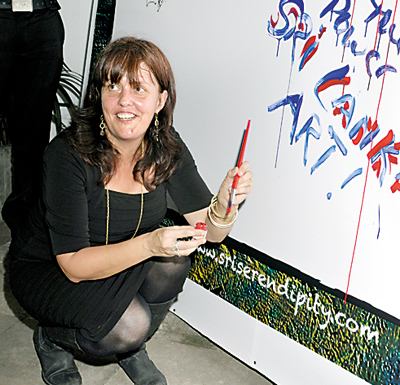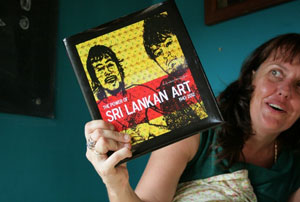Let us play our role in the Asian renaissance of the 21st century
Considering the name of the most recent book launched on Sri Lankan art, ‘The Power of Sri Lankan Art 1943 – 2012’, I think the question ‘Does Sri Lankan art have any power?’ is a good topic to be debated. Judging whether it has any power or not, is up to you, but the history of Sri Lankan art goes a long way back. I am not going to elaborate on this history. But the rich history of art we have in Sri Lanka could be symbolized with only three art objects.
Namely the Sigiriya frescoes, the gold gild Tara at the British Museum and the gold gild Veheragala Avalokiteshwara at the Colombo Museum. These are just a few examples of the power of ancient Sri Lankan art. However, today I am going to briefly analyse only the contemporary role of Sri Lankan art.

Juliet Coombe at the launch of the book The Power of Sri Lankan Art
Western Art primarily came to Sri Lanka in 1891, under the British Colonial rule. The Ceylon Society of Arts then promoted this art here, with the assistance of Colombo-based upper class artists, mainly English speaking, and also through an art-appreciative audience. Among other disciplines, art education in Ceylon also began with the establishment of the Maradana Technical College in 1893 and with that knowledge and use of western art techniques and styles began to flow into the country. But the subject of modern art was introduced to Sri Lanka by Europeans around 1920. In the 1940s, the Sri Lankan art scene captured the attention of the international art audience with many articles being published in foreign magazines regarding Sri Lankan artists and their work.
This happened because many artists, both group and solo, tirelessly and enthusiastically worked in different mediums and styles to express their feelings, concepts, ideas and views through the visual language. They participated in international exhibitions and their work was acquired for public display, won awards and so contributed to the world history of art. How successful they have become can be seen by the inclusion of 52 artists and their work in this book. This is remarkable, as the support they got from the government was almost non-existent.
In the mid 1970s, as a result of a long struggle by art students, teachers and intellectuals, visual art education was upgraded to a university standard and the first batch of graduate painters, sculptors and designers flowed into society at the end of the decade.
Likewise, at present, we are in the middle of a controversy regarding the aptitude test, which is being held to select the most suitable group of students for our practical-oriented degrees. Though it has been scrapped from the selection criterion by the Ministry of Higher Education, it is a must to keep the high standard of the art field. In the meantime, the Sri Lankan art scene was affected several times by race riots, two insurgencies in the South, and 30 years of civil war in the Northern part of the country. During this time, we lost creative youngsters, works of art and many monographs and this took us backwards by leaps and bounds. There was no museum to safeguard works of art.
The lack of a Sri Lankan Modern Art museum had a negative impact as there was no place to record and preserve art. Many valuable works of art along with the technical know-how and motivation behind them was lost because of the worsening situation in the country. It was the dragging point of the field. If it had not happened, we would have been far ahead in the art scene internationally. It is embarrassing to note here that we are still in need of a Modern Art Museum. In this atmosphere, the contribution of individuals, Non-Governmental Organizations, publishers and gallery owners is most valuable and highly appreciated. In the past century, we used to wait for European and American art biennale exhibitions; like in Venice, Sao Paolo, and Havana etc. But now at present, we are more attentive towards Eastern art events like the art triennial in Delhi and the biennales in Singapore, Beijing, Dhaka, Fukuoka and now also in Colombo. The change of the world art scene, from West to East, can be judged by this. Not only in Asia but also in the Middle East, the Pacific region, Africa, Latin America and Eastern Europe a rising appreciation of non western forms of visual expression can be clearly seen.
All these works of art carry geopolitical meanings, multiculturalism, hybrid identities and individual concepts and creativity. In this regard, Asia is becoming a new creative hub in the 21st century. Sri Lanka, because of its location, has always been a very important maritime centre of Asia and is one of the nicest countries in the world to live and work in, where the environment is supportive to creativity and talent-based industries. Considering this, Sri Lanka has all the major factors to play a key role in the Asian renaissance of the 21st century. We already have creative ability and ambition as well as tradition and experience from our ancient art history. A creative industry is being formed in Asia at the moment, as in the West.
If this historical situation could be correctly understood, the power of Sri Lankan art can be invested to produce good results. We know that there is a growing art market centering on Colombo. There are several private galleries exhibiting art in and around Colombo and even outstation. At the same time, works of art from Sri Lanka are being exhibited in galleries all over the world and in private collections. Sri Lankan artists join world art forums, art camps and workshops to present their work, with innovative experimentations, that they have been engaged in for a long time, with materials and ideas. Parallel to these attempts by practitioners, there are many catalogues, books, articles and papers being published regarding Sri Lankan Art. However there is nothing in the field like ‘The Power of Sri Lankan Art 1943 – 2012’, published by the Sri Serendipity Publishing House. The volume comprises over 50 Sri Lankan Artists and their work spanning 70 years.
In one way, it is a promotion of the Sri Lankan contemporary art scene and in another it is a documentation of the history of art in the country. It brings about an awareness of our rich present artistic culture, both locally as well as internationally.
The Power of Sri Lankan Art 1943 – 2012 can be bought for Rs. 5000 at Barefoot, Odel and all leading bookshops. It can also be directly purchased from Sri Serendipity Publishing House– Call Juliet Coombe on 0776838659 or visit www.sriserendipty.com.
comments powered by Disqus


























